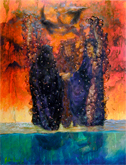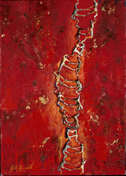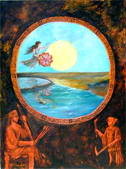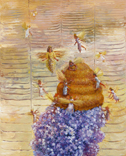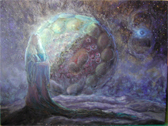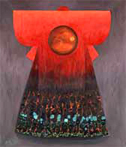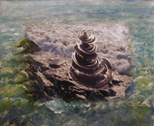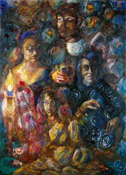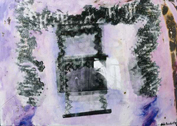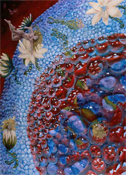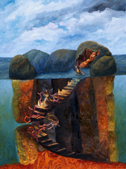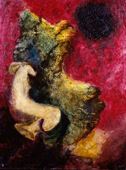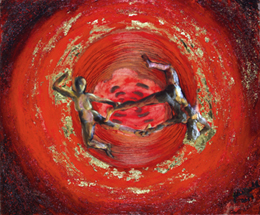
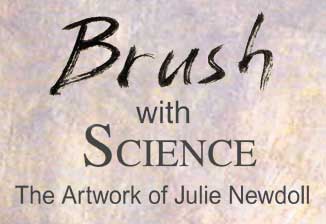
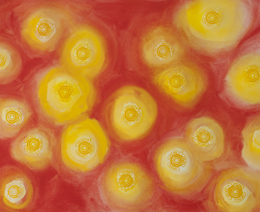
...Julie Newdoll merges life science and culture, myths and molecules in her
paintings, music, journal covers and science games.
Shakespeare:
A Mirror up to Science
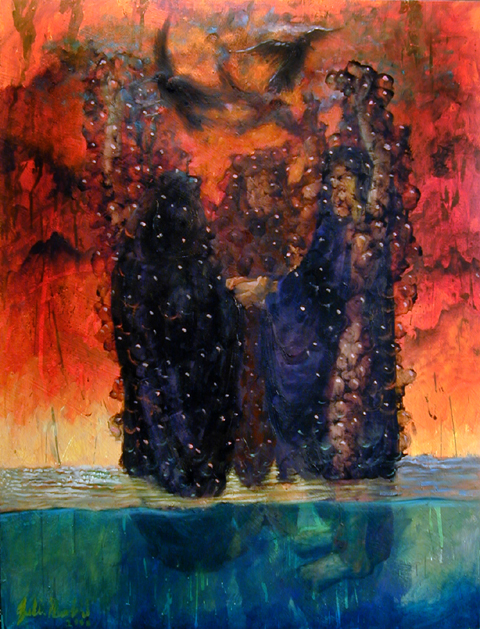
Three Fas identical sister proteins protrude above the cell surface. They are being organized by a death signal in the form of three Ravens, which represent the homotrimeric molecule, CD95L. Once the external trimeric FAS molecule has bound to its ligand, CD95L, the pathways of apoptosis are triggered inside the cell.
Inspired in part by the paper Death Receptors: Signaling and modulation, by Avi Ashkenazi and Vishva M. Dixit, Science, Vol. 281, 1305-1308, 1998, and the paper "BCL-2 family members and the mitochondria in apoptosis", Aton Gross, James McDonnell, Stanley Korsmeyer, Genes and Development, 13:1899-911, 1999.
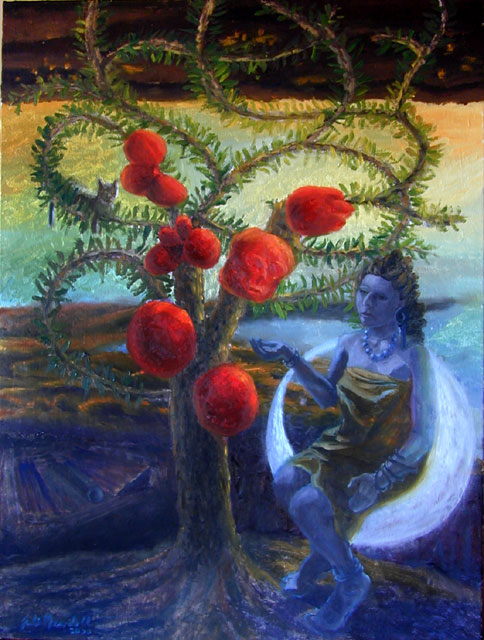
Chain of Life, 23" x 30", 2013. Inks, watercolor, relief print made from rubber stamps by the artist. $800. Prints available $450.
This painting was originally a special commission for Dr. Zbigniew Darzynkiewicz. The premise for this painting resides in the paradox of being both dead and alive at the same time. In the tree, one can find “Schrodinger’s cat”, in reference to the analogy used in quantum physics where a cat can be both dead and alive in the quantum world. The large red fruits in the tree are calabash fruits, modeled after cells which have been studied both while dead and alive. The large, full fruits are like healthy living cells and the multi-lobed fruits are more like apoptotic cells, or cells that died via a preprogrammed internal mechanism for cell suicide*. The woman sitting in the moon is Blood Moon, from an ancient Mayan legend found in the Popul Vuh**. She holds out her hand to accept a fruit from the tree. The central fruit with a skull imbedded in it is the head of One Hunahpu. He has been beheaded and his head stuck in a tree by the lords of the underworld after going there to accept their challenge to a ball game. Instead of giving her one of the fruits, he spits in her hand, saying,
“It is just a sign I have given you, my saliva, my spittle. This, my head, has nothing on it--just bone, nothing of meat. It’s just the same with the head of a great lord: it’s just the flesh that makes his face look good. And when he dies, people get frightened by his bones. After that, his son is like his saliva, his spittle, in his being, whether it be the son of a lord or the son of a craftsman, an orator. The father does not disappear, but goes on being fulfilled. Neither dimmed nor destroyed is the face of a lord, a warrior, craftsman, orator. Rather, he will leave his daughters and sons. So it is that I have done likewise through you. Now go up there on the face of the earth; you will not die.”
Inspired by the paper "The Schrodinger's Cat Quandary in Cell Biology: Integration of Live Cell Functional Assays with Measurements of Fixed Cells in analysis of Apoptosis", by Xun Li and Zbigniew Darzynkiewicz, Experimental Cell Research 249, 404-412, 1999. Translation of the "Popul Vuh: The Mayan Book of the Dawn of Life", by Dennis Tedlock, Simon & Schuster Trade, 1995, ISBN: 0684818450
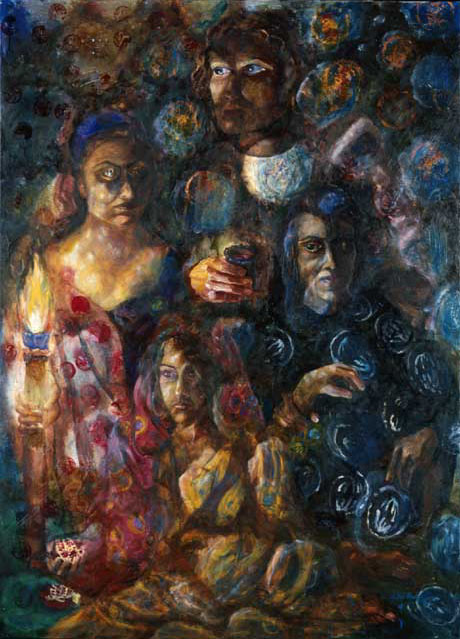
Greek Tragedy and the Life and Death of the Cell, 4' x 5', 1997. $8,000.Prints available $450.
This is a special painting because it is the first in the series, the first painting which fuses mythology and science in any of Julie Newdoll's paintings, and a painting with close friends as models. It was also the first painting she consulted with Zbigniew Darzynkiewicz, prominent scientist, who supplied her with unique imagery she used for this and many future paintings.
Necrobiology is the study of cell death. Apoptosis is one mechanism of cell death dealt with in the "Inside Time" series. In the study of cell death, cells commit murder, suicide, incur accidental death, and sacrifice themselves for the good of the community of cells. This sounded so much like a Greek tragedy to me, I could not help juxtaposing the two. This painting portrays a key character in the origins of Greek Tragedy , Dionysis, and some characters that are related to him, Hades, Persephone, and Demeter, whom all have cyclic lives. Four stages in the cycle of a cell are stamped on the four characters. They are seen through a screen of apoptotic cells (cells undergoing cell death).
*Formerly titled "Greek Tragedy through Necrobiology". Inspired in part by the paper "Detection of Apoptosis and DNA Replication by Differential Labeling of DNA Strand Breaks with Fluorochromes of Different Color", Xun Li, Myron R. Melamed and Zbigniew Darzynkiewicz, Experimental Cell Research 222, 28-37 (1996). Special thanks to Dr. Darzynkiewicz.
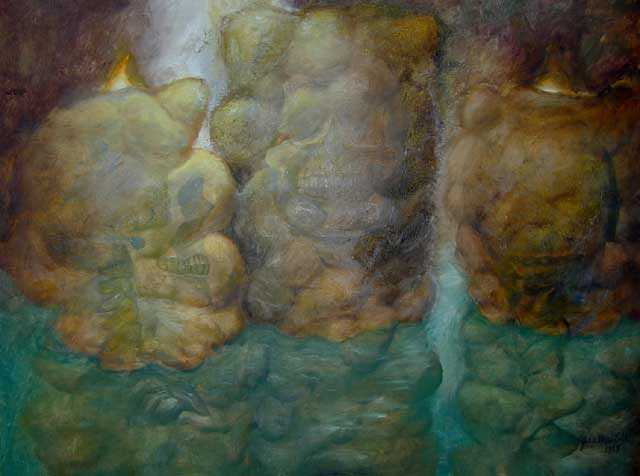
Bax Twins Delivering Death, 33" x 44", 1999.
$900. Prints available $450.
The element Boron, number five in the periodic table, can form cages in a repeating pattern as a pure element.
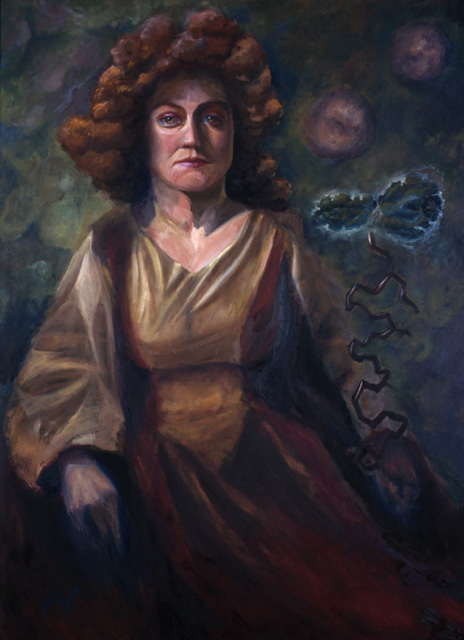
Apoptosis Queen: 33" x 44", 2000. $1,200 in solid walnut frame.Prints available $450.
The Apoptosis queen holds a piece of protein in her left hand called BH3, which is most likely necessary in all pro-apoptotic proteins involved in the organelle destruction pathway of apoptosis. Her hair reflects the shape of the apoptotic protein BID, which is part of this group of proteins.
Inspired in part by the papers BCL-2 family members and the mitochondria in apoptosis, Aton Gross, James McDonnell, Stanley Korsmeyer, Genes and Development, 13:1899-911, 1999, and by "Analysis of Apoptosis by Laser Scanning Cytometry, Bedner E; Li X; Gorczyca W; Melamed MR; Darzynkiewicz Z, Cytometry 35:1810195, 1999.
Programmed
Cell Death:
Apoptosis
